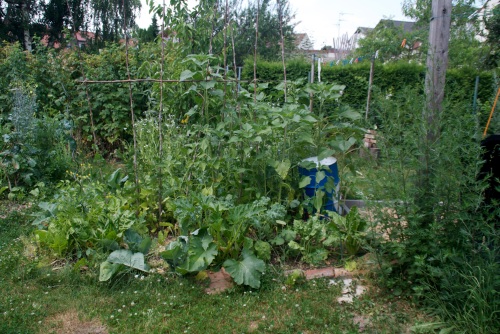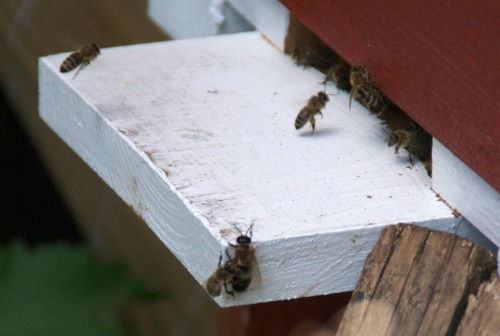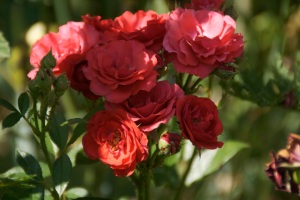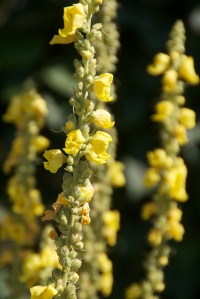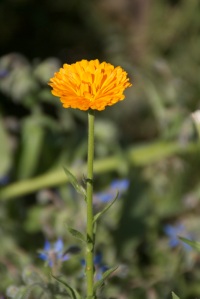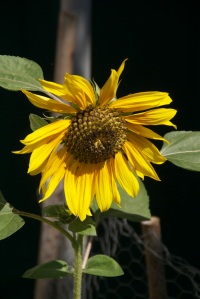Vor kurzem ist jemand mit den Suchbegriffen “essbare Bodendecker” auf meinen Blog gestoßen. Das fand ich interessant und dachte, darüber könnte ich ja mal schreiben….
Bodendecker sind toll – sie helfen gegen Austrocknung und Erosion, halten den Boden kühl und sind oft auch noch trittfest.
Wenn man sie dann auch noch essen oder anderweitig nutzen kann, ist es eigentlich perfekt, oder?
Hier ein kleiner Überblick über einige essbare (oder sonstwie nützliche) Bodendecker:
Neuseeländer Spinat (Tetragonia tetragonioides): Dieses bei uns einjährige Blattgemüse sät sich selbst aus. Bodendeckend bleibt er aber nur, wenn man ihn regelmäßig beerntet, sonst bildet er aufsteigende Triebe, die bis zu zwei Meter hoch werden! Er hat sehr fleischige Blätter und ist daher nicht trittfest. Er ist eher etwas für sonnige Standorte.
Portulak (Portulaca oleracea): Wie der Neuseelandspinat sät auch er sich selbst aus und hat fleischige Blätter. Die Blätter sind kleiner, aber trotzdem sehr lecker. Er ist auch eher etwas für sonnige Standorte. Portulak bleibt auch ohne Ernten klein, ist aber auch nicht trittfest.
Kapuzinerkresse (Tropaeolum majus): Kapuzinerkresse verteilt sich auch schön auf dem Boden und sät sich ebenso begeistert selbst aus. Hier wird man auch noch mit hübschen Blüten belohnt und kann nicht nur Blüten und Blätter essen, sondern auch die unreifen Samenkapseln als Kapern-Ersatz einlegen. Auch nicht trittfest.
Gundermann (Glechoma hederacea): Gundermann ist ein wunderbarer Bodendecker – er bleibt klein, ist einigermaßen trittfest (keine Pflanze für einen viel benutzten Weg), wächst fast überall (sicher auch unbemerkt in deinem Garten) und hat hübsche violette Blüten. Die Blätter haben einen sehr intensiven Geschmack und machen sich gut in Kräuterbutter. Gundermann vermehrt sich fröhlich selbst schlägt beim Wachsen immer mal wieder Wurzeln, so dass man ihn gut über Ableger vermehren kann.
Scheinerdbeere (Potentilla indica): Auch sie breitet sich schnell selbst durch Ableger aus und ist trittfest. Sie hat kleine gelbe Blüten und Erdbeerähnliche Blätter. Den Walderdbeeren am ähnlichsten jedoch sind die fade schmeckenden, aber essbaren Früchte. Martin Crawford vom Agroforestry Research Trust nutzt die jungen Blätter der Scheinerdbeere als Salat.
Walderdbeere (Fragaria vesca): Ist der Standort eher schattig, bietet sich die Walderdbeere an. Sie ist relativ trittfest, blüht schön und die kleinen Erdbeeren sind meist viel aromatischer als die großen Arten. Die Blätter können auch für Tee verwendet werden.
Himalaja-Himbeere (Rubus nepalensis): Diese Himbeerart habe ich auch in Martin Crawfords essbarem Waldgarten kennengelernt. Sie wächst auch im Vollschatten, wird bis 20 cm hoch, ist absolut trittfest und macht leckere Beeren. Außerdem ist sie nicht so stachelig wie die “normale” Himbeere.
Thymian: An warmen, sonnigen Standorten eignen sich kleinbleibende Thymianarten, die einen duftenden Teppich bilden (Thymus caespititius) und mit ihren Blüten auch noch Insekten anlocken. Relativ trittfest, hat man dann einen dichten Rasen, den man für den Küchen- und Teegebrauch auch beernten kann.
Kamille: Neben der strahlenlosen Kamille (Matricaria discoidea) gibt es auch Sorten der römischen Kamille (Chamaemelum nobilis), die kleinbleibend sind und als Rasenkamille verkauft werden. Gut trittfest und duftend.
Giersch (Aegopodium podagraria): Während die Gärtner, die Giersch in ihrem Garten haben, jetzt sicher die Hände über dem Kopf zusammenschlagen, führe ich ihn der (un-)Vollständigkeit halber mal auf. Giersch ist sehr trittfest und absolut robust. Man kann die jungen Blätter essen und wenn man ihn lässt, bildet er weiße Blüten (die aber schon mal einen Meter hochstehen). Es gibt ihn in grün und auch in panaschiert. Allerdings ist beim Giersch höchste Vorsicht geboten: Er breitet sich gerne aus und ist sehr schwer wieder “einzufangen”. Zum Glück kann man ihm ganz gut mit Sheet Mulch Einhalt gebieten.
Beeren: Es gibt viele kleinbleibende Beerenarten, wie die europäische Blaubeere (Vaccinium myrtillus), Preiselbeere (Vaccinium vitis-idaea), Krähenbeere (Empetrum nigrum), Cranberry (Vaccinium oxycoccos) und die Shallon-Scheinbeere (Gaultheria shallon).
Einige von ihnen haben allerdings ganz bestimmte Bodenansprüche (sauer, mager…) weswegen “normaler” Gartenboden meist nicht geeignet ist. Ansonsten sind sie aber trittfest und als Waldpflanzen in der Regel auch schattentolerant.
Niedere Scheinbeere (Gaultheria procumbens): Diese Pflanze ist in den Wäldern des Nordostens Amerikas heimisch. Die Blätter ergeben einen leckeren Tee und die Früchte haben ein minziges Aroma. Wie die anderen Heidekrautgewächse bevorzugt auch die Niedere Scheinbeere saure Böden, ist daher eher was für moorige Gegenden.
Kriechende Mahonie: Ein weiterer interessanter Bodendecker ist die kriechende Mahonie (Mahonia repens). Sicher trittfest ist sie trotzdem eher was für Stellen, die man nicht betritt, denn sie ist ziemlich stachelig. Allerdings blüht sie im Frühjahr wunderbar gelb und zieht mit ihrem starken Duft nicht nur Bienen an. Die Beeren sind essbar, allerdings sehr sauer.
Kriechender Rosmarin (Rosmarinus officinalis ‘Prostratus’): Wie der Thymian liebt auch der kriechende Rosmarin sonnige Fleckchen, bedankt sich aber mit aromatischen Blättchen, die ein tolles Gewürz sind, und mit schönen Blüten. Bedingt trittfest und vom Boden her meiner Meinung nach anspruchslos.
Vogelmiere (Stellaria media): Eine meiner Lieblingspflanzen ist die Vogelmiere. Sie wächst gerne wo es feucht ist, gerne auch ein wenig schattig und breitet sich dort auch gerne aus. Sie schmeckt saftig, erdig und lecker, steckt voller Vitamine und Mineralien und ist auch medizinisch nutzbar. Wie der Name schon sagt mögen sie auch Vögel. Da sie sehr fleischig ist, nimmt sie es einem übel,wenn man sie häufig betritt.
Breitwegerich (Plantago major) : Ihn kann man direkt auf den Weg pflanzen – er wird nicht umsonst Wegerich genannt. Mit seinen essbaren Blättern und seiner großen Heilkraft gehört auch er zu meinen Lieblingspflanzen. Er wächst auch auf trockenem harten Boden und ist eine der Pionierpflanzen, wenn es gilt “Erdwunden” zu besiedeln.
Beinwell: Beinwell reichert den Boden mit Stickstoff an und seine im Überfluss wachsenden Blätter sind toller Mulch und gut für Jauchen. Die Zwergformen (Symphytum ibericum) bleiben recht klein, sind aber nicht sonderlich trittfest. Dafür wachsen sie eigentlich überall. Beinwell breitet sich über Wurzelstückchen aus, aber wenn man in seiner Nähe nicht umgräbt (oder Mäuse und Maulwürfe hat), bleibt er wo er soll.
Nun hoffe ich einen kleinen Überblick und neue Inspirationen zum Thema Bodendecker gegeben zu haben. Habe ich was vergessen? Habt ihr noch interessante Bodendecker?
Edit: Dank meiner aufmerksamen Leser hier noch zwei Bodendecker, die ich selber im Garten habe und lieber, aber dennoch vergessen hatte:
Waldmeister (Galium odoratum), Blätter bis zur Blüte für Maibowle; Vorsicht, enthält Cumarin.
Duftveilchen (Viola odorata), Blätter und Blüten essbar, wunderbarer Duft.
_________________
Recently somebody found my blog using the terms “edible ground cover” in his search. I found that very interesting and decided to write something about it…
Groundcover is great – it helps against evaporation and erosion, keeps the ground cool and often you can even walk on it.
And if you can then also eat it or use it for something, it’s perfect, right?
Here a little overview about edible (or otherwise useful) groundcover plants:
New Zealand Spinach (Tetragonia tetragonioides): In temperate climate only annual this groundcover plant with edible leaves reseeds itself happily. It only stays a groundcover, however, if you harvest it regularly, otherwise it forms erect shoots that can grow up to two meters! NZ spinach has very succulent leaves and stems and therefore shouldn’t be stepped on. It’s something for sunny spots.
Common Purslane (Portulaca oleracea): Like the NZ Spinach it also reseeds itself and has succulent edible leaves. Those are smaller but nevertheless delicious. Purslane is happy in sunny, moist spots and stays low even without harvest. Shouldn’t be stepped on.
Nasturtium (Tropaeolum majus): Nasturtiums like to sprawl and will reseed itself. It doesn’t only have edible leaves, but also beautiful edible flowers that will add both beauty and spice to your salad! Even the unripe seedpods can be used as a pickled caper substitute. Not to be stepped on.
Creeping Charly (Glechoma hederacea): A wonderful ground cover – it stays small, is pretty tolerant to being stepped on, grows almost everywhere and has beautiful purple flowers. The leaves have a very strong taste and are nice in herb butters. Creeping Charly propagates itself happily by taking root here and there where it touches the ground, so you can easily layer it.
Mock Strawberry (Potentilla indica): It also likes to take root along its way and will spread quickly. It can be stepped on and sports little yellow flowers and strawberry-like fruit that are bland but edible. Martin Crawford of the Agroforestry Research Trust recommends the young leaves for salads.
Forest Strawberry (Fragaria vesca): Is the spot for your future ground cover rather shady, forest strawberries will do well. It can be stepped on, has pretty flowers and will reward you with tiny strawberries that are usually a lot more aromatic than any big one you can find! The leaves can also be used for tea.
Nepalese Raspberry (Rubus nepalensis): I first met this kind of raspberry in Martin Crawford’s edible forest garden in Devon, England. It grows even in full shade, gets only up to 20 cm high, is absolutely tolerant to being stepped on and makes delicious berries. And what’s best: It’s not as prickly as the common raspberries!
Thyme: Sunny, warm spots are great for thyme and varieties that stay small (Thymus caespititius) will form a lovely smelling carpet and attract pollinators with their little flowers. Relatively tolerant to being stepped on, thyme creates the sort of lawn that can be harvested for kitchen and medicinal use.
Chamomile: Apart from the pineapple weed (Matricaria discoidea) there are also kinds of the Roman chamomile (Anthemis nobilis) that stay small and are being sold as “lawn chamomile”. Can be stepped on and smells good.
Ground ivy (Aegopodium podagraria): While the gardeners amongst you who have it in their garden are probably shaking their heads now, I will still mention the ground ivy. It is very tolerant to being stepped on and absolutely robust. You can eat the young leaves and if you let it it flowers nicely (but grows then up to 1 meter high). The “wild form” is green, but there are also variegated varieties. Watch out though, ground ivy likes to spread like mad and if you once let it get out of control, it’s hard to get rid of. Luckily it’s well to deal with if you use sheet mulch.
Berries: There are many prostate kinds of berries such as the European blueberry (Vaccinium myrtillus), lingonberry (Vaccinium vitis-idaea), crowberry (Empetrum nigrum), cranberry (Vaccinium oxycoccos) and shallon (Gaultheria shallon).
Some of them have very specific requirements as to where they like to grow (acid soil, …), so “normal” garde soil often doesn’t suit them. Otherwise they’re ok to walk on every now and then and being forest plants often also shade-tolerant.
Wintergreen (Gaultheria procumbens): Winterberry is a native to Northeast America. The leaves make for a nice tea and the fruit has a minty flavour. Just like other heather family plants, winterberry also prefers acid soil.
Creeping mahonia: Another interesting groundcover is the creeping mahonia (Mahonia repens). It doesn’t mind being stepped on, but since it is quite prickly I wouldn’t recommend it. It flowers beautifully in spring and the strong scent and yellow blossoms area bee magnet. The berries are edible, but very tart.
Creeping rosemary (Rosmarinus vulgaris ‘Prostatus’): Just like thyme, rosemary is something for sunny spots. The aromatic leaves are a great spice, however, and it has pretty blueish blossoms. Nothing for paths, but otherwise pretty easy to keep.
Chickweed (Stellaria media): One of my favourite plants is chickweed. It likes to grow in moist and also shady areas and likes to spread. Chickweed tastes juicy, earthy, fresh and delicious, is full of vitamins and minerals and Susun Weed recommend some medicinal use for it, too. The name also tells you how much birds love it. Shouldn’t be stepped on much.
Greater plantain (Plantago major): You can plant it right in the path, it’s so hardy! Its edible leaves and its amazing medicinal value make it also one of my favourites. It is a pioneer plant that comes to “heal” disturbed ground, so it can even grow in dry compacted soil.
Comfrey (Symphytum sp.): Comfrey is a nitrogen-fixer and its abundantly growing leaves are great for mulch and compost teas. S. ibericum stays small, but none of the comfreys is very happy about being stepped on. However, they grow pretty much everywhere. Comfrey can spread like mad by root cuttings, but as long as you don’t dig in its vicinity (and as log as the cats keep a check on mice and moles), it stays where it should.
I hope you enjoyed this little overview over edible ground covers! Do you know any other interesting ground covers?
NOTE: I live in a temperate climate. So any time I write “warm and sunny” I am talking about warm and sunny in a temperate zone. If you’re living, for example, the south of the US, a plant that I described as loving it warm and sunny might prefer partial shade. Ask your neighbours, friends, local nurseries or consult a book before planting!
Edit: Thanks to my faithful readers, here two more groundcovers I have in my own garden and love, yet forgot:
Woodruff (Galium odoratum), leaves until flower for May wine; watch out, contains cumarin.
Violet (Viola odorata), leaves and flowers edible, lovely scent.






